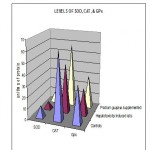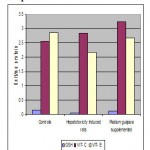How to Cite | Publication History | PlumX Article Matrix
Julius* and Lavanya
Department of biochemistry, Sree Balaji Dental College, Bharath University of Higher Education and Research, Narayanapuram, Pallikaranai, Chennai – 600 100 India.
ABSTRACT: In this study the antioxidant properties of Psidium guajava was identified, by supplementing its leaf extract to the antioxidant and antioxidant enzyme levels depleted rats.
KEYWORDS:
CCl4 (Carbon tetrachloride) hepatotoxicity; Psidium guajava supplementations
Download this article as:| Copy the following to cite this article: Julius. Lavanya. Ameliorating Effects of Psidium Guajava Leaf Extracts in Restoring the Normalcy of Antioxidants and Antioxidant Enzymes. Biosci Biotechnol Res Asia 2009;6(2) |
| Copy the following to cite this URL: Julius. Lavanya. Ameliorating Effects of Psidium Guajava Leaf Extracts in Restoring the Normalcy of Antioxidants and Antioxidant Enzymes. Biosci Biotechnol Res Asia 2009;6(2). Available from: https://www.biotech-asia.org/?p=9054. |
Introduction
Psidium guajava L, belonging to the Myrtacea family, has been reported to have anti-diarrheal, hepatoprotective, hypoglycemic, lipid lowering, antibacterial and antioxidant activities. In Malaya, it is generally known either as guava or jambu batu (Morton, 1987). Guava fruit is higher in vitamin C than citrus fruits and contains appreciable amounts of Vitamin A as well Guava fruits are also a good source of pectin (Sunttornusk L, 2005). pentacyclic triterpenoid:guajanoic acid and four known compounds-beta-sitosterol, uvaol, oleanolic acid and ursolic acid, have been recently isolated from the leaves of P. guajava (Begum et al. , 2004). In a study carried out with leaf extract of the plant, inhibition of gastrointestinal release of acetylcholine by quercetin present in extract was suggested as a possible mode of action in the treatment of acute diarrheal disease (Lutterodt, 1989, 1992; Lin et al , 2002)… Leaf extract of guava had ionotropic effect on guinea pig atrium (Conde Garcia et al. , 2003).In a study of aqueous extract of P. guajava in acute experimental liver injury induced by carbon tetrachloride, paracetamol and thioacetamide, it showed hepatoprotective activity. The effects observed were compared with a known hepatoprotective agent, silymarin. Histological examination of the liver tissues supported hepatoprotection (Roy et al. , 2006). In other animal studies, guava leaf extracts have shown central nervous system (CNS) depressantactivity (Shaheen,2000).
Materials and Methods
Experimental Design
The animals were divided into four groups of six animals each.
Group I : Normal Control Rats
Group Ii : Hepatotoxicity Control Rats
Group Iii : Hepatotoxicity rats were given Psidium guajava leaf extract (300mg/Kgbody/wt/rat/day) in aqueous solution for 10 days,
Antioxidant Enzymes and Antioxidants
Superoxide dismutase was assayed by the method Misra and Fridovich (1972) Catalase activity was assayed by the method of Sinha (1972), Glutathione peroxidase was assayed by the method of Rotruck et al (1973). Glutathione – S – transferase was assayed by the method of Beutler (1984). Reduced glutathione was determined by the method of Elman et al.,(1959). vitamin E was estimated by the method of Desai (1984).Vitamin C was estimated by the method of Omaye et al (1979).All the grouped data were statistically evaluated with SPSS/7.5 software.Hypothesis testing methods included one way analysis of variance (ANOVA) followed by least significant difference (LSD) test; p values of less than .05 were considered to indicate statistical significance. All the results were expressed as the mean + SD for six animals in each group.
Results and Discussion
Effect of Psidium Guajava on the Level of Enzymic and Non-Enzymic Antioxidants in Control and Experimental Groups of Rats.
Table – 1 & 2 shows the levels of both enzymic and non enzymic antioxidants such as SOD, CAT, GPx, GST, GSH, Vitamin-C and Vitamin-E in liver tissues of the control and experimental group of rats. In CCl4 induced rats, the levels of SOD, CAT, GPx, GST, GSH, Vitamin-C and Vitamin-E were significantly (p<0.05) decreased when compared with normal control rats, and they were found to regain normalcy after the supplementation of Psidium guajava leaf extracts.. Guava has antioxidant properties attributed to polyphenols found in its leaves. Guava fruit and leaf showed antioxidant and free radical scavenging capacity (Hui-Yin Chen et al. , 2007)
Table – 1
| Particulars | Controls | Hepatotoxicity Induced rats | Psidium guajava supplemented rats |
| SOD (Unit/mg protein | 10.372±1.631 | 6.802*±0.1063 | 9.161*±0.1441 |
| CAT (Unit/mg protein) | 61.28±9.66 | 44.36*±7.00 | 57.24*±8.947 |
| Gpx (Unit/mg protein) | 33.84±5.30 | 24.16*±1.64 | 29.55*±4.60 |
| GST (Unit/mg protein) | 0.54±0.08 | 0.18*±0.02 | 0.47*±0.075 |
Table – 2
| Particulars | Controls | Hepatotoxicity Induced rats | Psidium guajava supplemented rats |
| GSH (Unit/mg protein) | 0.15±0.02 | 0.053*±0.008 | 0.12*±0.01 |
| VIT– C (Unit/mg protein) | 2.55±0.40 | 2.84*±0.48 | 3.25*±1.42 |
| VIT E (Unit/mg protein) | 2.87±0.45 | 2.18*±0.35 | 2.67*±0.38 |
Values are given as mean ± SD for groups of six animals each.
Values are statistically significant at *P < 0.05.
Hepatotoxic rats were compared with control rats. Psidium guajava supplemented rats were compared with control rats.
 |
Graph 1
|
 |
Graph 2
|
The above graph – 1 & 2 shows the levels antioxidant enzymes (SOD, CAT, GPx, GST) and antioxidants (GSH, VIT – C, VIT – E) of Controls, Hepatotoxicity induced by CCL4 induced rats and Psidium guajava supplemented to Hepatotoxicity induced rats.
References
- Morton J, Guava In: Fruits of warm climates, Julia F. Morton, Miami FL, 356-363. (1987),
- Sunttornusk L, , J.Pharm. Biomed. Anal, 28(5), 849-55. (2002),
- Begum S, Hassan SI, Ali SN, Siddiqui BS, Nat Prod. Res, 18(2), 135-140. (2004),
- Lutterodt GD, , J. Ethnopharmacol, 37(2), 151-157. (1992),
- Lin J, Puckree T, Mvelase TP,. J. Ethnopharmacol, 79(1), 53-56. (2002),
- Hui-Yin Chen, Gow-Chin Yen, , Food Chemistry, 101(2), 686-694. (2007),
- Conde Garcia EA, Nascimento VT, Santiago, Santos AB, , Braz. J of Med. and Biol Res, 36, 661-668. ( 2003),
- Roy CK, Kamath JV, Asad M, , Indian J Exp Biol, 44(4), 305-311. (2006),
- Shaheen HM, , Phytother.Res, 14(2), 107-111. (2000),
- Misra, H.P. and Fridovic, I. J.Biol.Chem., 247, 6969-6962.(1972)
- Sinha, A.K. Anal.Biochem., 47, 389-394. (1972)
- Rotruck, J.T., Pope, A.L., Ganther, H.E., Swanson, A.B., Hafeman, D.G. and Hoekstra, W.G. Science, 179, 588-590. (1973)
- Beutler, E., Duron, D. and Delly, B.M. J.Lab.Clin.Med., 61,882-888. (1963)
- Ellman G.L.. Arch Biochem Biophys 82:70-77. (1959)
- Desai ID. Method in Enzymol 105:138-147. (1984),
- Omaye, S.T., Turnbull, J.D. and Sauuberilich, H.E., Method.Enzymol., 62, 1-11,(1979)

This work is licensed under a Creative Commons Attribution 4.0 International License.





